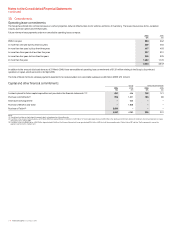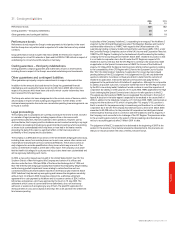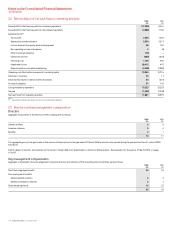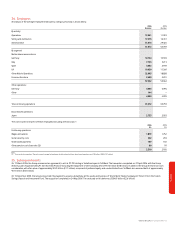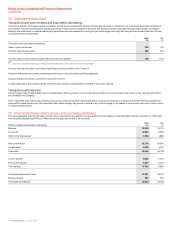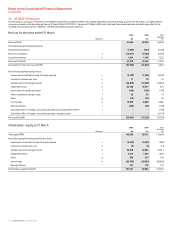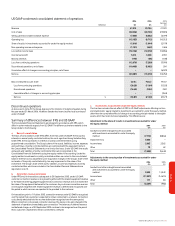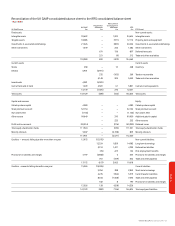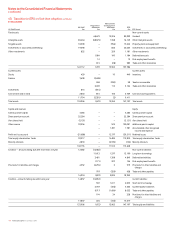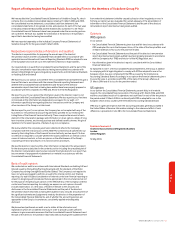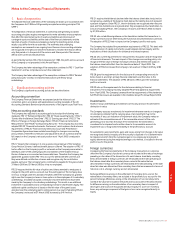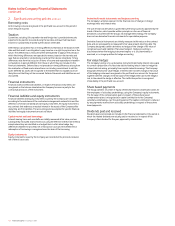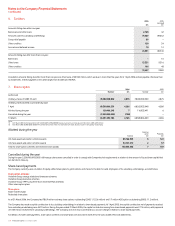Vodafone 2006 Annual Report Download - page 128
Download and view the complete annual report
Please find page 128 of the 2006 Vodafone annual report below. You can navigate through the pages in the report by either clicking on the pages listed below, or by using the keyword search tool below to find specific information within the annual report.
126 Vodafone Group Plc Annual Report 2006
Notes to the Consolidated Financial Statements
continued
Employee benefits – actuarial gains and losses (IAS 19, “Employee Benefits”)
The Group has elected to recognise all cumulative actuarial gains and losses in relation
to employee benefit schemes at the date of transition.
Share-based payments (IFRS 2, “Share-based Payment”)
The Group has elected to apply IFRS 2 to all relevant share-based payment transactions
granted but not fully vested at 1 April 2004.
Financial instruments (IAS 39, “Financial Instruments: Recognition and
Measurement” and IFRS 7, “Financial Instruments: Disclosures”)
The Group has applied IAS 32 and IAS 39 for all periods presented and has therefore not
taken advantage of the exemption in IFRS 1 that would enable the Group to only apply
these standards from 1 April 2005.
Cumulative translation differences (IAS 21, “The Effects of Changes in Foreign
Exchange Rates”)
The Group has deemed the cumulative translation differences at the date of transition
to IFRS to be zero. As a result, the gain or loss of a subsequent disposal of any foreign
operation will exclude the translation differences that arose before the date of transition
to IFRS.
If the Group had not applied the exemption, the gain or loss on any disposals after the
transition date would include additional cumulative transaction differences relating to
the businesses disposed of.
Fair value or revaluation as deemed cost (IAS 16, “Property, Plant and Equipment”
and IAS 38, “Intangible Assets”)
The Group has not elected to measure any item of property, plant and equipment or
intangible asset at the date of transition to IFRS at its fair value.
40. Transition to IFRS on first-time adoption
Basis of preparation of IFRS financial information
The Group’s Annual Report for the year ended 31 March 2006 is the first annual
Consolidated Financial Statements that comply with IFRS. The Consolidated Financial
Statements have been prepared in accordance with the significant accounting policies
described in note 2. The Group has applied IFRS 1, “First-time Adoption of International
Financial Reporting Standards” in preparing these statements.
IFRS 1 exemptions
IFRS 1 sets out the procedures that the Group must follow when it adopts IFRS for the
first time as the basis for preparing its Consolidated Financial Statements. The Group is
required to establish its IFRS accounting policies as at 31 March 2006 and, in general,
apply these retrospectively to determine the IFRS opening balance sheet at its date of
transition, 1 April 2004. This standard provides a number of optional exemptions to this
general principle. These are set out below, together with a description in each case of
the exemption adopted by the Group.
Business combinations that occurred before the opening IFRS balance sheet date
(IFRS 3, “Business Combinations”)
The Group has elected not to apply IFRS 3 retrospectively to business combinations that
took place before the date of transition. As a result, in the opening balance sheet,
goodwill arising from past business combinations remains as stated under UK GAAP at
31 March 2004.
If the Group had elected to apply IFRS 3 retrospectively, the purchase consideration would
have been allocated to the following major categories of acquired intangible assets and
liabilities based on their fair values: licence and spectrum fees, brands, customer bases, and
deferred tax liabilities. Goodwill would have been recognised as the excess of the purchase
consideration over the fair values of acquired assets and liabilities – retrospective
application may have resulted in an increase or decrease to goodwill. The fair values of the
acquired intangible assets would have been amortised over their respective useful lives.
Impact of transition to IFRS
The following is a summary of the effects of the differences between IFRS and UK GAAP on the Group’s total equity shareholders’ funds and profit for the financial year for the years
previously reported under UK GAAP following the date of transition to IFRS.
Total equity shareholders’ funds 1 April 2004 31 March 2005
Note £m £m
Total equity shareholders’ funds (UK GAAP) 111,924 99,317
Measurement and recognition differences:
Intangible assets a (164) 13,986
Proposed dividends b 728 1,395
Financial instruments c 385 350
Share-based payments d1263
Defined benefit pension schemes e (257) (361)
Deferred and current taxes f (1,011) (774)
Other (66) (176)
Total equity shareholders’ funds (IFRS) 111,551 113,800
Profit for the year ended 31 March 2005 Note £m
Loss on ordinary activities after taxation (UK GAAP) (6,938)
Measurement and recognition differences:
Intangible assets a 14,263
Financial instruments c (174)
Share-based payments d (91)
Defined benefit pension schemes e7
Deferred and current taxes f10
Other (130)
Presentation differences:
Presentation of equity accounted investments g (45)
Presentation of joint ventures h (384)
Profit for the financial year (IFRS) 6,518
There were no significant differences between IFRS and UK GAAP on the Group’s cash flow statement for the year ended 31 March 2005.


